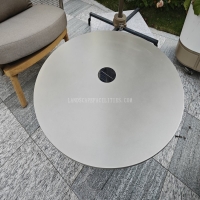Welcome to the website for landscape facilities products and knowledge.
What are the friction coefficients for different surface finishes on landscape tables?
When selecting materials for landscape tables, understanding friction coefficients is crucial for safety, functionality, and aesthetics. Different surface finishes exhibit varying levels of sliding resistance, which can impact user experience. Here’s a breakdown of common materials and their typical friction coefficients:
1. Wood (Natural or Sealed):
- Friction Coefficient: 0.2–0.6 (varies with moisture and finish).
- Smooth finishes reduce friction, while rough or textured wood provides better grip.
2. Metal (Powder-Coated or Polished):
- Friction Coefficient: 0.1–0.3 (lower for polished surfaces).
- Powder coatings can slightly increase friction compared to bare metal.
3. Stone (Granite, Slate, or Concrete):
- Friction Coefficient: 0.4–0.7 (higher for rough textures).
- Honed or polished stone reduces friction, while flamed or bush-hammered finishes enhance grip.
4. Composite Materials (Recycled Plastic or Resin):
- Friction Coefficient: 0.3–0.5 (depends on texture additives).
- Textured composites mimic natural materials while offering consistent performance.
Factors like weather, wear, and maintenance also influence these values. For high-traffic areas, opt for finishes with higher friction to prevent slips. Conversely, sleek finishes suit decorative tables where minimal resistance is desired. Testing under real-world conditions ensures optimal results for your landscape design.
Related search:

Recommendation
Outdoor stainless steel table with solar-powered ambient lighting feature - excellent design.